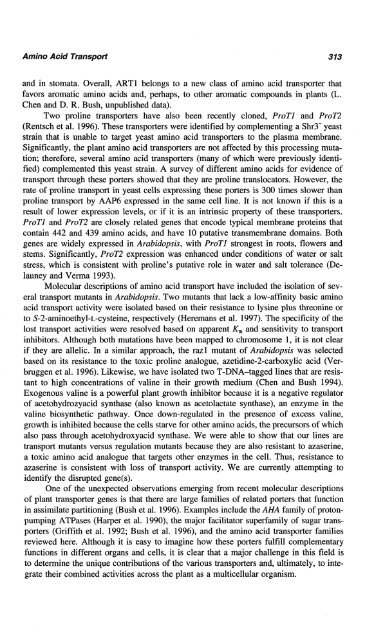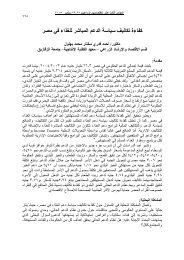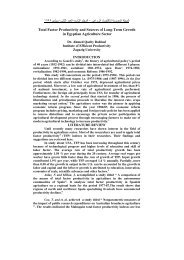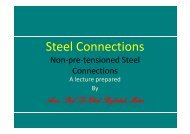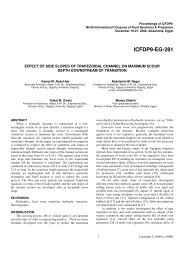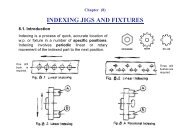Amino Acid Transport
Amino Acid Transport
Amino Acid Transport
- No tags were found...
You also want an ePaper? Increase the reach of your titles
YUMPU automatically turns print PDFs into web optimized ePapers that Google loves.
and in stomata. Overall, ART1 belongs to<br />
favors aromatic amino acids and, perhaps,<br />
Chen and D. R. Bush, unpublished data).<br />
Two proline transporters have also<br />
a new class of amino acid transporter that<br />
to other aromatic compounds in plants (L.<br />
been recently cloned, ProTl and Pro72<br />
(Rentsch et al. 1996). These transporters were identified by complementing a Shr3- yeast<br />
strain that is unable to target yeast amino acid transporters to the plasma membrane.<br />
Significantly, the plant amino acid transporters are not affected by this processing mutation;<br />
therefore, several amino acid transporters (many of which were previously identified)<br />
complemented this yeast strain. A survey of different amino acids for evidence of<br />
transport through these porters showed that they are proline translocators. However, the<br />
rate of proline transport in yeast cells expressing these porters is 300 times slower than<br />
proline transport by AAP6 expressed in the same cell line. It is not known if this is a<br />
result of lower expression levels, or if it is an intrinsic property of these transporters.<br />
ProTl and ProT2 are closely related genes that encode typical membrane proteins that<br />
contain 442 and 439 amino acids, and have 10 putative transmembrane domains. Both<br />
genes are widely expressed in Arabidopsis, with ProTl strongest in roots, flowers and<br />
stems. Significantly, Pro22 expression was enhanced under conditions of water or salt<br />
stress, which is consistent with proline’s putative role in water and salt tolerance (Delauney<br />
and Verma 1993).<br />
Molecular descriptions of amino acid transport have included the isolation of several<br />
transport mutants in Arabidupsis. Two mutants that lack a low-affinity basic amino<br />
acid transport activity were isolated based on their resistance to lysine plus threonine or<br />
to ~-2-~inoethyl-~-cysteine, respectively (Heremans et al. 1997). The specificity of the<br />
lost transport activities were resolved based on apparent K, and sensitivity to transport<br />
inhibitors. Although both mutations have been mapped to chromosome 1, it is not clear<br />
if they are allelic. In a similar approach, the raz1 mutant of Arabidopsis was selected<br />
based on its resistance to the toxic proline analogue, azetidine-2-carboxylic acid (Verbruggen<br />
et al. 1996). Likewise, we have isolated two T-DNA-tagged lines that are resistant<br />
to high concentrations of valine in their growth medium (Chen and Bush 1994).<br />
Exogenous valine is a powerful plant growth inhibitor because it is a negative regulator<br />
of acetohy~ozyacid synthase (also known as acetolactate synthase), an enzyme in the<br />
valine biosynthetic pathway. Once down-regulated in the presence of excess valine,<br />
growth is inhibited because the cells starve for other amino acids, the precursors of which<br />
also pass through acetohy~oxyacid synthase. We were able to show that our lines are<br />
transport mutants versus regulation mutants because they are also resistant to azaserine,<br />
a toxic amino acid analogue that targets other enzymes in the cell. Thus, resistance to<br />
azaserine is consistent with loss of transport activity. We are currently attempting to<br />
identify the disrupted gene(s).<br />
One of the unexpected observations emerging from recent molecular descriptions<br />
of plant transporter genes is that there are large families of related porters that function<br />
in assimilate partitioning (Bush et al. 1996). Examples include the AHA family of protonpumping<br />
ATPases (Harper et al. 1990), the major facilitator superfamily of sugar transporters<br />
(Griffith et al. 1992; Bush et al. 1996), and the amino acid transporter families<br />
reviewed here. Although it is easy to imagine how these porters fulfill complementary<br />
functions in different organs and cells, it is clear that a major challenge in this field is<br />
to determine the unique contributions of the various transporters and, ultimately, to integrate<br />
their combined activities across the plant as a multicellular organism.


